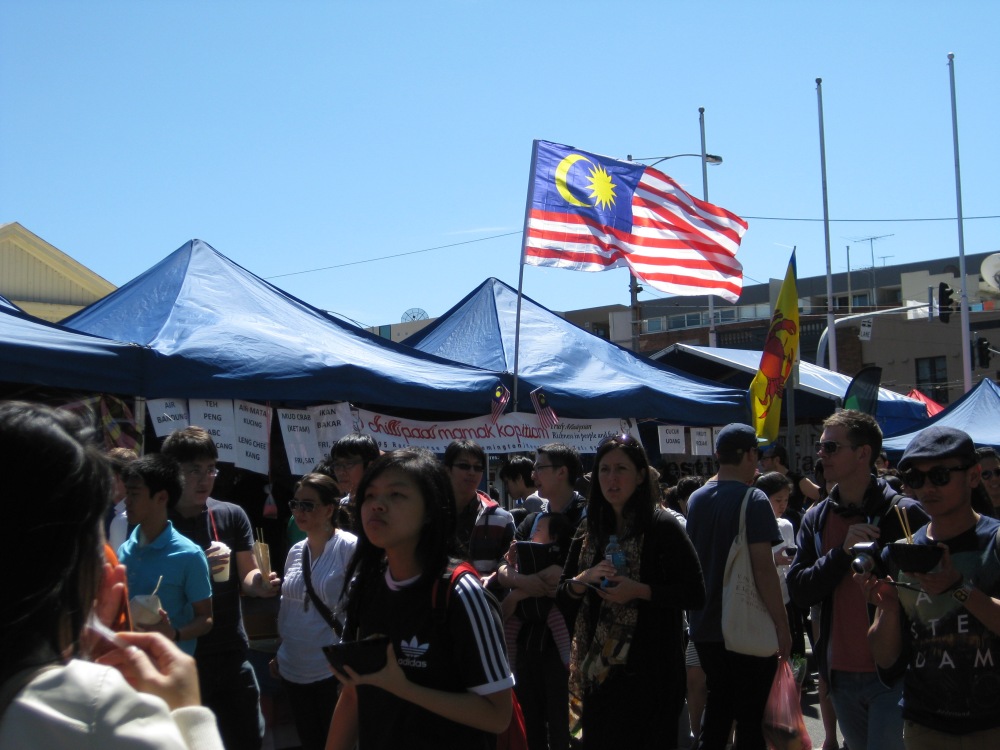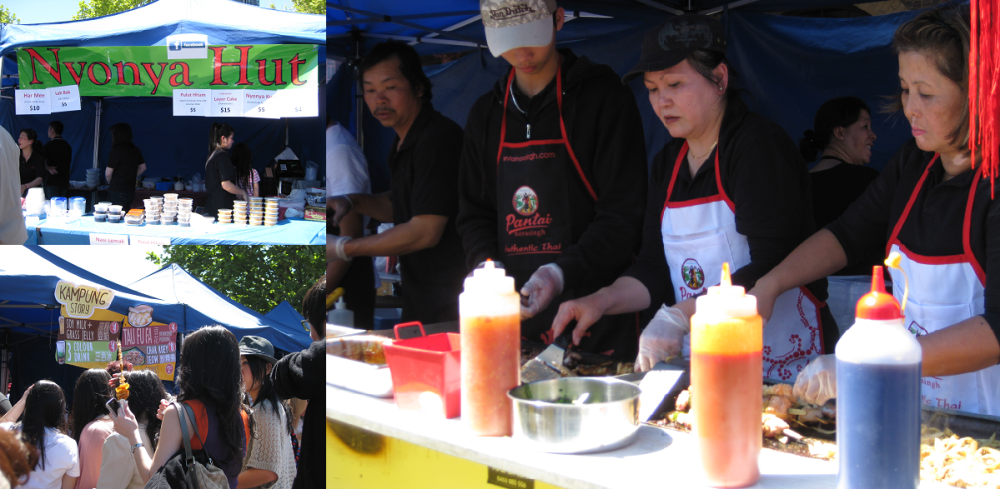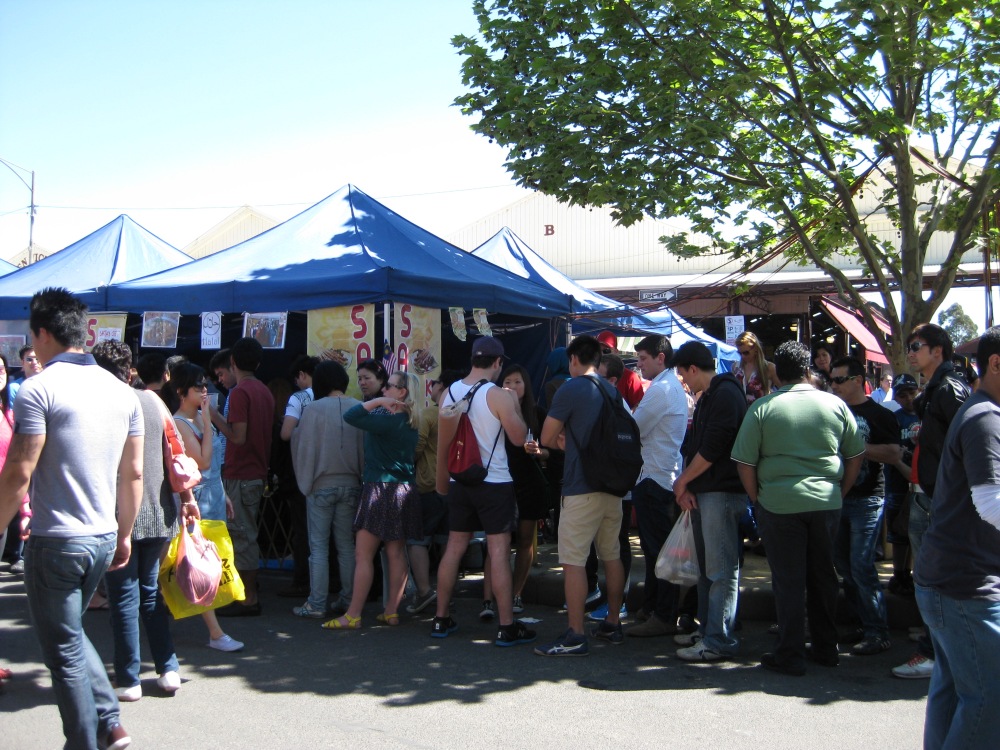A couple of weeks ago, I decided to check out the Malaysia Street Festival at Queen Victoria Market. I was expecting this event to showcase only Malaysian street food, but lo and behold, I discovered non-Malaysian food was on offer as well.
I ambled up to the festival just after 1p.m. on an exquisite blue sky Sunday, and it was packed. People stood shoulder to shoulder akin to sardines in a tin can at the Market’s carpark area where food stalls were set up in a neat row. Some people stood in enormously long queues for food, while others simply crowded around stalls gawking at the colourful, mouth-watering dishes on display.
I also spied with my little myopic eyes a Malaysian flag stuck high and mighty on top of one of the stalls, flying majestically in the slight breeze. A small yet significant mark of Malaysian pride in a city that is home to many Malaysian immigrants and international students.
I began squirming my way around the bodies congregating at the festival in order to get a good look at what was being served up at the stalls. Malaysian street food was the order of the day, in line with the festival’s name. Char kuey teow (fried flat rice paper noodles), tau fu fa (dessert consisting of soft white beancurd doused in sweet syrup) and nyonya kuih-muih (sweet, sticky Malay cakes usually made with glutinous rice flour) were just some of the many traditional Malaysian dishes on offer.
Malaysian drinks were of abundance too. Plenty of fresh coconuts were cracked open so one could savour their saccharine sweet juices. Stall attentively brewed brightly coloured Malaysian concoctions such as pink coloured bandung (milk flavoured with rose cordial) and stark white soya bean milk on the spot.
I couldn’t help but feel a strong ‘Malaysian atmosphere’ present as I was ogling at the stalls. This was not only because of the distinctive Malaysian cuisine available, but also because the chefs used gigantic woks and frying pans to whip up the delectable dishes with their culinary flair right in front of everyone’s faces – just as they do back in Malaysia on the streets, hawker-style. What’s more, there were no proper tables and chairs set up so everyone sat around on any seatable surface to chow down food and guzzle beverages. All these factors combined together: that’s the typical outdoor Malaysian eating take-away experience.
As I meandered deeper into the festival, all of sudden I spotted a large, prominent sign on a stall reading ‘Korean Twist Potato’. What nonsense is this? What’s non-Malaysian food doing here in a Malaysian festival? I pondered.
To me, the stall – with awkward twisty-potato things popped on sticks displayed right at the front – stood out like a sore thumb amidst all the Malaysian-themed ones. The Malaysian-atmosphere I had been feeling since I arrived at the festival was suddenly partially dashed.
Puzzled, I wandered away from the Korean stall and journeyed on into the festival. A few strides later, I came face-to-face with a stall selling Churros. Chocolate coated Churros. Spanish food.
A few metres later, I came across a stall selling bubble-tea. A drink that has origins in Taiwan.
And suddenly I remembered the poster for the event did mention that the festival featured dishes from ‘Vietnam, Thailand’ etc.
Feeling a little woozy from standing a wee bit too long in the merciless burning Australian sun, I moved to stand in the shade. I started thinking as the world continued to turn.
Having other Asian and European cooking on offer ostensibly gives less space to showcase Malaysian delectable, delish delights at the Malaysia Street Festival. Malaysia is made up predominantly of three races – Malay, Chinese and Indian – and so there are quite a few iconic dishes that can be showcased. One can fairly argue that these non-Malaysian gastronomic delights are cramping Malaysian cuisine’s style.
Such ‘foreign’ dishes can be seen as infiltrating and stepping all over the ‘Malaysian spirit’ of the festival.
And going somewhat out on a limb here, some naïve Anglo-Australians who have little knowledge about Malaysia can mistake the non-Malaysian ones for Malaysian cuisine.
But at the same time, there are always two sides to the coin. As an eternal pessimist who always tries to be optimistic so as to generate hope in any situation, I started thinking more positively about the Malaysia Street Festival.
The presence of other South-East Asian – and European – foods here can in fact instill an appreciation for various Asian cuisine among locals who are generally unfamiliar with them. Anglo-Australians or people of non-Malaysian descent would usually head down to such a Malaysian event because 1) of an interest in Malaysian food and/or 2) are curious to try and know more about such cuisine. Those strolling around this festival who have some knowledge about Malaysian food would generally be able to pinpoint quite a few of the country’s dishes – and once they’ve gotten their fix of such cuisine, non-Malaysian foods such as the Korean Potato Twist beckon. And do they dare try this twisty thing? Judging from the humongous queues the Korean stall and other non-Malaysian food stalls were attracting, I daresay, they do.
For individuals clueless about all things Malaysian, most non-Malaysian stalls were adorned with signs such as ‘Indonesian’, ‘Korean’ and ‘Spanish’, so it would be fairly easy for these individuals to distinguish them from the authentic Malaysian food stalls. Once these people have sampled Malaysian delights, why not have a go at the non-Malaysian ones as well? I’m sure some of them did.
For Malaysians in attendance at the festival, well, it is clearly an opportunity for them to relish their favourite Malaysian dishes cooked hawker-style. Period.
The air at the festival definitely reeked of multiculturalism. There were stalls side-by-side, each selling a different kind of Asian/non-Asian street food. I could see Chinese, Malays and Indians determinedly queuing up for them. Chinese people waiting in line for traditional Malay satay. Chinese people lining up for Taiwanese bubble tea. Chinese and Malays patiently waiting for a stick of Korean Twist Potato to be served to them.
This is the essence of what I term the ‘modern Malaysian spirit’ that is fond of virtually any kind of food on the planet. Traditional authentic Malaysian (street) food are – and will continue to be – undoubtedly favourites among Malaysians today. But, other types of Asian/European chow are becoming increasingly popular with Malaysians and are eaten regularly, especially by the younger generation.
In short, a part of the modern Malaysian spirit is about diversity and taking an interest in other cultures, getting to know them. Many of my Malaysian friends absolutely love getting to know people from Korean/Japanese/Italian backgrounds and often never hesitate to dine on pizza, Korean fried chicken and French pastries both here in Aussieland and back home. On a regular basis.
With pals of different ethnicities.
On a tangent, it is not really a secret that racial discrimination and inequalities are rife in Malaysia today, but that’s another story altogether. And it really doesn’t have a connection with Malaysian food.
On a positive note, it can be arguably said the Malaysia Street Festival gives Melbourne a taste and a rather apt impression of what modern Malaysian culture – or Malaysia – is like today. With mostly Malaysian and a sprinkling of non-Malaysian food stalls set up side-by-side, the festival sends out the subliminal message that a part of the modern multicultural Malaysian spirit entails lapping up the nation’s and Malaysian’s favourite traditional dishes and being adventurous and open, trying foreign culinary delights big and small.
And I stress ‘a part of’ because multiculturalism is not just about food and festivals, but it is also about harmoniously interacting with people with various backgrounds and respecting their cultural values.
Feeling much cooler standing in the shade, I looked at the festival from a distance. There were long queues and crowds at both Malaysian and non-Malaysian food stalls. No one was pushing or shoving. I saw many people chatting and smiling happily, clutching boxes and bowls of Malaysian – and also presumably non-Malaysian – street food. Laughter rang in my ears.
Everyone’s having a good time shoveling their faces with food and mingling with one another, so what’s the problem? Multiculturalism has to start somewhere, I thought.
With these thoughts in my mind, I stepped out into the blazing sun – so reminiscent of Malaysia’s hot weather – and walked away with a good feeling about this festival.




Awesome article! Very reflective and thoughtful and honest! It’s great to see diversity and people willing to try different things. And you’re right, multiculturalism isn’t just about food, somewhere in the Australian education system or media they need to acknowledge what people from diverse communities have brought to us other than food. But indeed, multiculturalism has to start somewhere, I certainly hope that people don’t take diversity for granted.
The other issue is that some people only have a limited amount of acceptance. For example, I know some people love Chinese food but when I talk to them about Chinese culture, history and language (and trying to explain to them why contemporary China is what it is now from the basis of what the country had experienced) they just don’t accept it and think Confucius is to blame (I mean, the guy died 2,000 years ago as if he would know what would happen after his death). Don’t know if this is slightly off tangent… 🙂
And once again, another awesome article. Keep up the great work Mabel! 🙂
LikeLike
Thank you for your encouragement! I suppose food is something that almost everyone is interested in (I mean we eat it, we need food to survive) because it’s easily accessible anywhere in developed parts of the world. Even ethnic food can be easily created and almost replicated authentically in Western cities with the right ingredients. With Asian or as you say Chinese culture, history and language, these are usually not readily present or created around us. It takes a lot of effort to preserve such awesome historical cultural values and memories let along introduce them in Western places, and even at times some of these traditional idea may get lost in translation.
I reckon people warm so much more eating to ethnic food than learning about a culture as the former is physical, it is something we can see and taste first-hand, and as such it’s much easier for people to connect with it.
LikeLike
I really like the way how you describe Malaysians. When it comes to food, you’re absolutely right. No borders whatsoever. Everyone just having a great time chowing down food together. 😉
LikeLike
Thank you very much Eric! Food is food! Let’s all have a good time eating! 😀
LikeLike